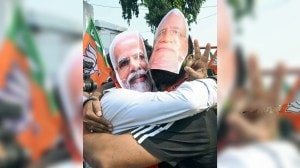The ‘return’ of Yogi of old: How UP CM is readjusting gears amid rifts in state BJP
Yogi Adityanath, who appeared to soften his “Hindutva leader” image after returning to power in 2022, has in recent days tightened anti-'love jihad' Bill, spoken about "securing Sanatan Dharma", and overseen a Kanwar Yatra marked by a cloud over nameplates on stalls.
 After returning to power in 2022, Adityanath seemed to moderate his stand even more, his anti-crime, bulldozer-borne drive now directed against known gangsters and their aides or strongmen accused of inciting violence. (X/@YogiAdityanath)
After returning to power in 2022, Adityanath seemed to moderate his stand even more, his anti-crime, bulldozer-borne drive now directed against known gangsters and their aides or strongmen accused of inciting violence. (X/@YogiAdityanath)Cautious about his Hindutva leader image as he embarked on his second straight tenure as Uttar Pradesh chief minister in 2022, Yogi Adityanath has hardened his Hindutva stance in recent weeks as internal differences in the state leadership of the BJP came to the fore in the aftermath of the party’s poor performance in the Lok Sabha elections. This is reflected in the decisions the Uttar Pradesh government has taken in the past month.
First was Adityanath’s intervention last month to assure the residents of two Hindu-dominated colonies in Lucknow — Pant Nagar and Indraprastha Nagar — that their homes would not be demolished. The residents were afraid because the Irrigation Department had marked the houses as being in the floodplain zone. On June 20, the Lucknow Development Authority (LDA) completed a months-long operation of demolishing 1,800 structures, including 1,169 houses and 101 commercial establishments on 24.5 acres in the Akbar Nagar locality in Lucknow after declaring they had illegally encroached on the floodplain zone beside the Kukrail river.
The matter has been a sticking point between the residents of such areas and the state administration over the last six months — there was also an incident in March of LDA officials being pelted with stones — and the matter reached the Supreme Court, which then approved the state administration’s actions.
The next big instance was the police passing an order for roadside vendors and shopkeepers along the Kanwar Yatra route to display their names outside their establishments. The directive, first announced by the police in Muzaffarnagar district last month, was attacked for being directed against Muslims. However, the Muzaffarnagar Senior Superintendent of Police (SSP) claimed it would prevent confrontations. Amid an uproar, the state administration stuck to its guns and a week later the directive was made applicable to other parts of the state through which the Kanwar Yatra was supposed to pass.
Then in late July, the state government tabled a Bill to amend the anti-conversion law, making the Uttar Pradesh Prohibition of Unlawful Conversion of Religion Act, 2021, more stringent. The UP Assembly passed the amendment Bill on July 30, again underlining its intent to quash “love jihad”, the term given to a conspiracy alleged by Hindu right-wing groups, including BJP leaders, that says Muslim men want to convert Hindu women by luring them into marriage.
Last week, in line with his tough-on-crime image, the CM directed police officers to reactivate the”anti-Romeo squads” that had been first launched after he took charge of the state in 2017. They were briefly redeployed in 2022 after Adityanath returned to power but were again put on hold. These squads, comprising mostly women police officials in civilian clothes backed by male cops, were started to crack down on the sexual harassment of women and girls on the streets. They were deactivated around 2019 following reports that they were harassing couples in public places.
Then, at an event last week where the statute of Ram Temple movement flag-bearer Paramhans Ramchandra Das was unveiled, Adityanath appealed for unity against an “impending crisis” threatening Sanatan Dharma. Referring to the construction of Ram Temple, he said it was not the “final destination” but a milestone and the campaign to “secure Sanatan Dharma” should continue.
Over the past weekend, Adityanath also weighed in on the Bangladesh crisis and the situation of Hindus in the neighbouring countries. He alleged the Opposition was tight-lipped about them because of vote-bank politics. “It is our duty to protect the Hindus of Bangladesh and support them in times of distress and we will always stand by them. No matter the circumstances, our values remain unshakable. Being a Hindu in Bangladesh is not a mistake but a blessing,” he said.
Shift in Yogi’s image
Yogi Adityanath’s political journey began after his Guru, Mahant Avaidyanath, transferred his political and religious responsibilities to him and he became the Gorakhpur MP in 1998. At the age of 26, he became one of the youngest parliamentarians to be elected to the Lok Sabha that year.
Soon after, the young mahant heading the all-important Gorakhnath Math burnished his image of being a strong Hindutva leader as, in 2002, he formed an outfit called the Hindu Yuva Vahini. This organisation of Adityanath’s foot soldiers spread across eastern UP over the next five years and wielded a lot of influence in districts such as Gorakhpur, Deoria, Kushinagar, Maharajganj, Sant Kabir Nagar, Basti, Siddharthnagar, Balrampur, Gonda, Faizabad, Mau, Azamgarh, Ghazipur, Jaunpur, and Ballia. By the start of 2011, the outfit recorded its presence in districts beyond eastern UP and formed central and west UP units.
The Vahini earned the identity of being cow vigilantes and joined individuals or Hindu groups in confrontations with members from another religion. Several of its office-bearers faced criminal cases for indulging in violence. Even Adityanath had cases lodged against him. In 2005, Adityanath, known at the time for his incendiary speeches, made his way towards Mau after communal riots erupted there but he was stopped. He was named in cases registered after communal riots erupted in Gorakhpur in January 2007 following the death of a Hindu youth. The government later withdrew the case.
Adityanath, however, tried to project a more moderate stand after becoming the Chief Minister in 2017. First, he dissolved the Hindu Yuva Vahini. But he balanced this with outreach to the followers of Hindutva. He started the custom of using helicopters to shower flower petals on pilgrims on Kanwar Yatra. This custom has continued every year since then. Adityanath also moved against illegal slaughterhouses, forcing their closure.
After returning to power in 2022, Adityanath seemed to moderate his stand even more, his anti-crime, bulldozer-borne drive now directed against known gangsters and their aides or strongmen accused of inciting violence. The CM also focused more on the development of Hindu pilgrimage sites such as Ayodhya, Varanasi, and Mathura and avoided making statements even when the heat got dialled up over court cases related to the Gyanvapi mosque dispute in Varanasi and the Krishnajanmabhoomi-Shahi Idgah mosque dispute in Mathura.
During the Lok Sabha elections this year, while the UP government’s bulldozer actions were much talked about by senior BJP leaders, who lauded the tough-on-crime approach of the Adityanath government, the UP CM himself did not play it up.
But now, with his rivals in the party finding their voice following the party’s poor performance in the parliamentary polls, Adityanath appears to be reverting to old.



- 01
- 02
- 03
- 04
- 05




























